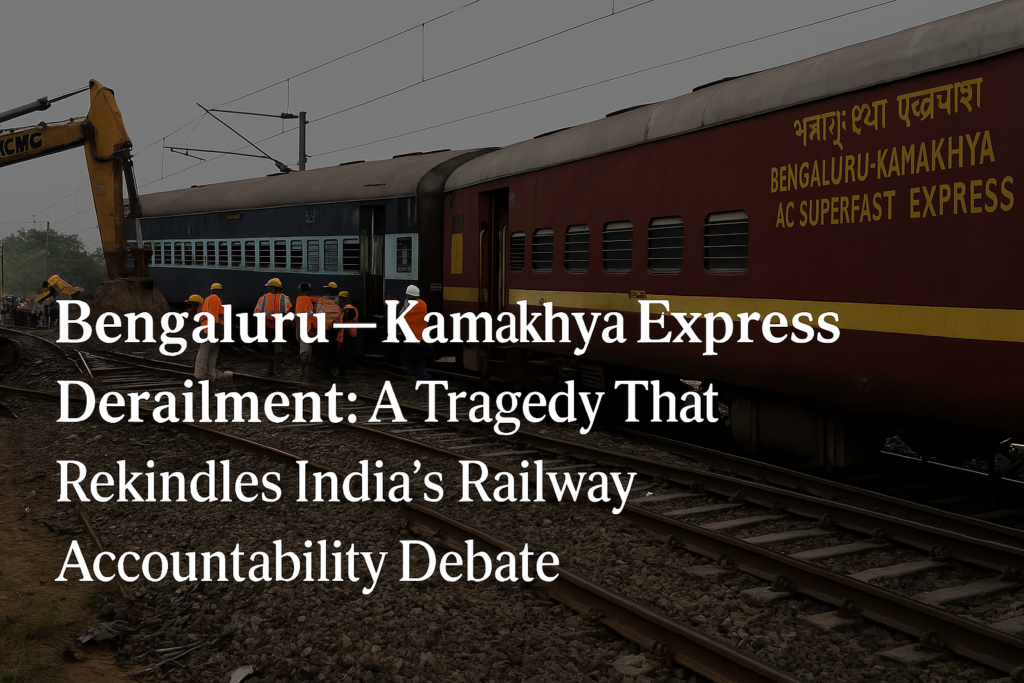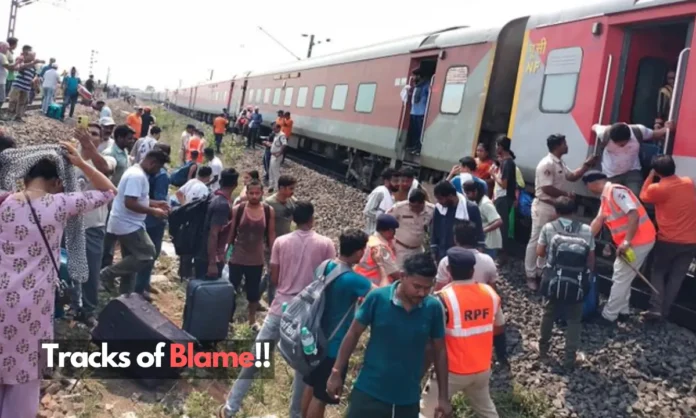Summary
- The derailment near Odisha’s Nergundi station killed one and injured several, prompting widespread calls for a high-level inquiry.
- Congress blames Union Railway Minister Ashwini Vaishnaw for repeated lapses in safety protocols, demanding immediate financial and medical aid for victims.
- The mishap once again raises concerns about systemic neglect, crisis response capacity, and the long-term safety of India’s vast railway network.
12551 SMVT Bengaluru – Kamakhya AC Express Derailed Near Cuttack; More Details Awaited #IndianRailways #trainaccident pic.twitter.com/971tUaTBZy
— Trains of India (@trainwalebhaiya) March 30, 2025
A Curve Too Many: Inside the Cuttack Tragedy
In the early hours of March 31, 2025, the Bengaluru–Kamakhya AC Superfast Express derailed near Nergundi station in Odisha’s Cuttack district. The accident, which led to the death of one passenger and left several others injured, has once again thrown India’s railway safety mechanisms into question.
While official rescue efforts were swift, the political aftermath was even quicker. The opposition Congress wasted no time in blaming Union Railway Minister Ashwini Vaishnaw for what it calls a “pattern of administrative failure and technical neglect.” At the accident site, Odisha Pradesh Congress Committee (OPCC) President Bhakta Charan Das criticized the Railways’ crisis response, demanded immediate compensation, and called for a high-level inquiry.
For passengers on board the train, the derailment was a night of chaos and fear. For the nation, it was a reminder that in one of the world’s largest rail networks, a single misstep can still cost lives—and reveal cracks in a system many assume is progressing.
The Collision of Tragedy and Accountability
- The Bengaluru Kamakhya Express derailment 2025 is the latest in a series of recent train accidents.
- Congress has accused the Railway Ministry of gross negligence, citing repeated failures to ensure operational safety.
- The Railways’ official statement emphasizes mechanical checks and weather conditions, but has not confirmed causes.
- Bhakta Charan Das visited the site, demanding ex gratia relief and immediate medical care for the injured.
- Public confidence in railway safety remains fragile amid increasing reliance on superfast and long-distance trains.
The political fallout from the Bengaluru Kamakhya Express derailment 2025 was immediate and fierce. In a public address, Congress leader Bhakta Charan Das said, “India has suffered the most tragic train accidents under Ashwini Vaishnaw’s tenure. And yet, he never owns responsibility.”
This sharp indictment echoes sentiments expressed after past derailments and collisions—many of which drew attention to outdated infrastructure, understaffed maintenance divisions, and underinvestment in preventive technology.
The Railway Ministry, meanwhile, maintained that all safety protocols were followed and that rescue operations began within minutes. Local MLA Souvic Biswal, who also visited the site, coordinated with railway and district authorities to ensure that injured passengers were admitted to SCB Medical College and Hospital in Cuttack. The ministry has yet to release an official statement on the exact cause of the derailment.
But critics say this reactive posture is part of the problem. “We cannot always play defense. Every accident is treated like a surprise. That’s not how modern rail networks function,” said a former Railway Board advisor who asked not to be named.

Safety on Track—or Derailed?
- India’s railway modernization programs have struggled to prioritize safety alongside speed and expansion.
- Over 100 train derailments have occurred annually on average over the last decade, according to safety audits.
- Staff shortages, outdated signaling systems, and delayed maintenance are frequently cited as causes.
- The Railways has rolled out Kavach (anti-collision tech), but its coverage remains limited.
- Passengers demand real-time transparency, automated alerts, and faster response units.
The Bengaluru Kamakhya Express derailment 2025 is part of a troubling trend that contradicts India’s ambition to modernize its railways. Despite the rollout of semi-high-speed trains like Vande Bharat, the core safety ecosystem for most long-distance routes remains patchy.
India still records a significant number of derailments annually, with causes ranging from fractured tracks and mechanical faults to human error and poor weather forecasting. Experts point out that while investment in high-profile projects grabs headlines, many routine safety upgrades—such as track renewal, signal modernization, and AI-based surveillance—are slow to scale.
Initiatives like “Kavach,” the indigenous Train Collision Avoidance System, are promising but remain under-implemented. As of early 2025, fewer than 5% of Indian trains are equipped with it.
What frustrates commuters most is the lack of timely information and proactive intervention. “There was chaos after the accident. No one told us anything. Only social media updates gave us clarity,” said a passenger who was traveling in coach B2.
From Protest to Policy Pressure
- Congress demands a high-level, time-bound inquiry with ministerial accountability.
- The party alleges “repeated dereliction of duty” under Railway Minister Vaishnaw’s leadership.
- Local administration has assured compensation and promised a full safety audit of the stretch.
- Civil society groups call for transparency in incident data and third-party rail safety reviews.
- The accident has rekindled fears about the railways being stretched thin between ambition and operational realism.
The Bengaluru Kamakhya Express derailment 2025 has emerged as more than just an operational error—it has become a lightning rod for political and civic pushback. The Congress party is leveraging the incident to mount a broader critique of the Modi government’s infrastructural claims, especially in the railways sector.
“This government likes ribbon cuttings more than route inspections,” said a statement from the OPCC, targeting what it calls the performative aspects of infrastructure governance. The party’s demands include not just financial compensation but a full public audit of derailment-prone zones and safety protocol compliance.
Simultaneously, independent civic groups and transport experts have called for a third-party national rail safety review board that functions autonomously from the Railway Ministry. They argue that relying on internal audits leads to underreporting and bureaucratic whitewashing.
State-level actors, including the Odisha government, have requested a central inquiry and committed to assisting with on-ground relief and insurance claims. But for the injured and the bereaved, assurances ring hollow without tangible change.
India’s Rail Balancing Act: Expansion vs. Security
The Indian Railways is attempting to modernize faster than at any point in its history. From bullet trains and electrification drives to semi-high-speed corridors and station redevelopment, the vision is ambitious. But as incidents like the Bengaluru Kamakhya Express derailment 2025 show, execution is inconsistent.
Speed without safety can be lethal. And innovation without introspection is short-lived.
Rail safety doesn’t demand dramatic breakthroughs—it requires basics: maintained tracks, trained staff, responsive communication systems, and accountable leadership. Until these are prioritized over optics, India’s railways may remain vulnerable, no matter how fast they move.


